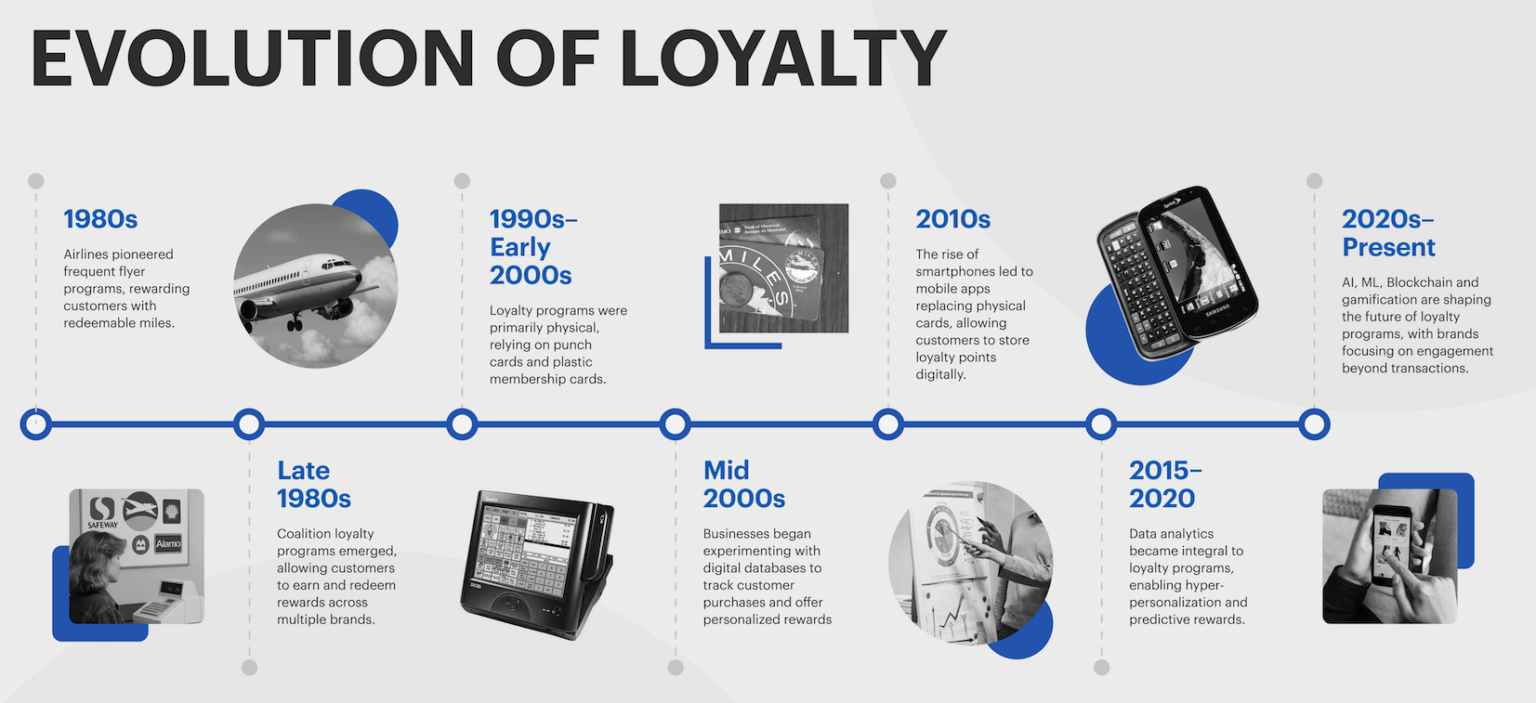By Raquel Jackson & Shivajee Dewangan | Aktivo Labs
Ahhh the ’80s – famous for big hair, double denim, shoulder pads, and the birth of the points-based loyalty program. Just as fashion has evolved over the decades, so too have consumers’ engagement with brands.
Today’s customers demand more than just points – they seek personalized experiences, seamless omnichannel interactions, and rewards that genuinely resonate with their lifestyles.
When American Airlines launched the world’s first frequent flyer program in 1981, it didn’t just change the game—it rewrote the rules entirely. Suddenly, loyalty wasn’t just a virtue; it was a currency, a strategic battleground where brands fought for the hearts (and wallets) of consumers.
Hot on its heels, American Express and Visa ushered in the era of financial reward schemes, transforming everyday spending into a playground of points and perks. What began as a bold innovation soon became the backbone of modern loyalty programs, forever altering the relationship between brands and their most devoted customers.
While innovation in loyalty has shaped consumer habits, true breakthroughs have been rare.
With perhaps the exception of Amazon Prime’s subscription-based model in 2005, shifts in the design of loyalty schemes have been more evolutionary, than revolutionary.
Moving from coupons, to cards, to mobile apps, from simple points to more dynamic rewards is by no means a small effort. It does however raise an important question: amid the push for better engagement, smarter marketing, and seamless omni-channel experiences, have brands lost sight of the most important piece of the puzzle – what the customer actually values?
Author, strategist, and civic engagement advocate Jon Alexander offers an insightful perspective on this. He argues that for decades, our world has been shaped by a dominant narrative: the “consumer story.”
In this paradigm, people are seen primarily as consumers – passive, self-interested, and reactive—choosing between pre-packaged options rather than actively shaping the world around them.
Alexander has some credentials in this space. His career began in advertising, where his job was to cut through the noise of 3,000 commercial messages a day to vie for consumer attention. The deeper he immersed himself in this task, the more he questioned the psychological and societal toll of this constant bombardment.
Alexander’s hypothesis? If we’re constantly told that we are nothing more than consumers, we start to believe it. In response, he began testing a simple yet powerful narrative shift—from “consumer” to “citizen”—with striking results.
The ‘citizen’ mindset fosters a sense of shared responsibility and purpose. Within the supplier/customer dynamic, it enables individuals to feel more aligned with a brand’s mission, value proposition, and goals – enhancing both engagement and proximity.
One could argue that the success of Alexander’s ‘citizen theory’ is a clear indication that in a world where brands aim to support citizens, not just serve consumers, programs that nurture long-term wellbeing – like those driven by lifestyle insights – build deeper trust and emotional loyalty.
The Signs of Decline
Loyalty programs have reached a tipping point. While membership numbers continue to climb, actual engagement is trending downward.
U.S. consumers now belong to an average of more than 15 programs, yet few actively participate in most of them.
Research from BCG and Forrester highlights a pattern of diminishing returns: as consumers sign up for more schemes, their attention and loyalty become increasingly fragmented. Yet you can’t walk three steps without knocking into another study, reporting on the high rates of positive consumer sentiment regarding the role loyalty programs play in their purchasing decision.
At the intersection of these conflicting findings lies a striking disconnect: loyalty programs – especially for points-based schemes – continue to influence behavior but not in the way brands intend.
In a crowded rewards landscape, similar structures and copycat incentives are creating fatigue, not differentiation. More programs, it turns out, do not equal more loyalty – they simply compete for the same sliver of shrinking consumer attention.
This misalignment, particularly stark in an era defined by big data and precision targeting, suggests a deeper shift in consumer sentiment is present and likely visible in the data – but perhaps not yet fully acknowledged.
For data-driven programs like loyalty schemes, identifying a decline should be straightforward – but accepting and acting on that decline is far more difficult.
History is littered with brands that failed to adapt to changing market conditions – Blockbuster, Kodak, Nokia, and Borders all ignored the signals until it was too late. Their stories remain powerful reminders of what happens when companies fail to listen to what the data – and more accurately the market – is telling them.
A September 2024 article in Harvard Business Review identified three key contributors to the erosion of loyalty programs:
- Lack of real consumer insight – In 2025, brands can no longer rely on historical data. Insights must be personal, immediate, and dynamic.
- Loss of proximity to buyers – The rise of digital media and the explosion of new, agile market entrants have made it harder for brands to maintain close, ongoing relationships with consumers.
- Unsustainable program economics – Maintaining a loyalty program that truly differentiates a brand and offers a fair, motivating value exchange is becoming increasingly difficult.
According to Harvard Business Review’s Consumer Insights Report, the consumer of today is a world apart from the flash-dancing archetype of the ’80s, people now expect more from the brands they choose. They want relationships, not receipts. Purpose, not points.
It’s clear that legacy loyalty programs aren’t keeping up with how people actually live. That’s where a new model – one rooted in everyday behavior and long-term wellbeing – comes in.
Hooked on Health – the New Loyalty Program Trend
Loyalty today boils down to a simple but powerful formula:
- Bring customers closer.
- Make it feel almost impossible to leave.
And from our experience, few things bring people closer – or anchor them more deeply – than their health. Some of today’s most forward-looking programs – including those powered by platforms like Aktivo – are redefining loyalty as something earned through healthier choices, not just spending.
A recent Boston Consulting Group survey revealed that right alongside media and entertainment, 35% of consumers rank health and wellness offerings among the top two types of paid memberships they’d be willing to invest in. The only category ranked higher was grocery and food subscriptions.
Bringing weight to this finding, the study also found that successful loyalty programs see as much as triple the customer engagement compared to others, and they capture a significantly larger share of their customers’ spending – on average, 35 percentage points more.
But it’s not just about offering a free yoga class or a sleep tracker. The most effective programs are those designed with real consumer habits, needs, and aspirations at their core.
They create value beyond the checkout line – offering support, insight, and motivation throughout the day. In doing so, they foster what behavioral economists call “high switching costs.” Not because customers are contractually locked in, but because they’re emotionally invested.
After all, when a brand is helping you feel better by partnering with you in your journey to live better, walking away doesn’t feel like switching – it feels like quitting on yourself.
The New Rules Shaping Loyalty Programs
When it comes to innovating with loyalty – there is plenty of advice. Here are the six most popular recommendations we found for connecting more deeply with today’s consumer:
- Offer more than a product. True loyalty grows when customers feel supported before, after, and beyond the purchase.
- Use smart data to personalize meaningfully. Health insights can transform generic messaging into something that actually matters to the individual.
- Show up consistently. Be more than a brand that sells—be a steady presence in your customers’ daily routines.
- Stand for something real. When your brand reflects a deeper mission, people don’t just buy from you—they believe in you.
- Meet people wherever they are. Life happens across channels. Your brand should flow with it, not fight it.
- Create spaces for shared progress. When people feel like they’re part of something bigger – a community working toward common goals – they stick around for more than just the perks.
Aktivo: AI-driven Risk & Loyalty Engine
One innovation leaning into this health-meets-loyalty future is Aktivo, an AI-driven platform designed to turn healthy habits into meaningful engagement.
Rather than relying on traditional loyalty tactics like discounts or generic rewards, Aktivo uses real-time activity data to power hyper-personalized experiences – meeting users exactly where they are in their wellness journey.
At its core, Aktivo’s engine analyzes lifestyle patterns such as movement, sleep, and recovery to generate an intelligent health score. Brands – including insurers, banks, FMCG, airlines and health services groups – then use these insights to tailor rewards, content, and messaging in ways that feel not only relevant but rewarding on a deeply personal level.
It’s not about pushing products – it’s about reinforcing behaviors that make people feel good, every single day.
The result? A loyalty loop driven not by transactions, but by transformation.
Aktivo doesn’t just help businesses build stickier relationships; it helps consumers build better habits. And when a brand becomes part of someone’s progress, they’re no longer just a vendor – they’re a partner in personal growth.
https://www.linkedin.com/pulse/healthy-new-trend-loyalty-programs-aktivo-labs-vueic/?trackingId=YrLjxc61QAieniEfZmgLeg%3D%3D


